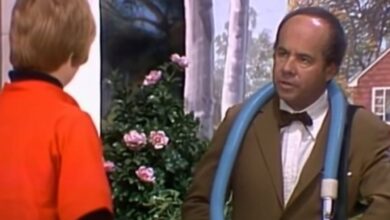Brenda Lee’s ‘I’m Sorry’ – The Song That Defined a Voice and Transcended Generations
In 1960, a 15-year-old Brenda Lee delivered a heart-wrenching ballad that would go on to define not just her career but an entire era of popular music. “I’m Sorry” was released as a single in the spring of that year, and its emotional depth, combined with Lee’s astonishingly mature voice, struck a chord with audiences worldwide. The song climbed to number one on the Billboard Hot 100, making Lee the youngest female artist at the time to achieve such a feat. Beyond its commercial success, “I’m Sorry” was pivotal in bridging the gap between rock and roll, pop, and country music, securing Lee’s place among the greats.
Born Brenda Mae Tarpley in Atlanta, Georgia, in 1944, Brenda Lee grew up in a working-class family where music was both an escape and a necessity. Blessed with an incredibly powerful voice, she began performing on local radio shows and talent competitions from a young age. By the time she was ten, she had already become a regional sensation. Her career took off when she was signed to Decca Records in the mid-1950s, where she first gained recognition for her rockabilly-infused tracks. But it wasn’t until the release of “I’m Sorry” that the world truly understood the depth of her vocal artistry.
The song itself was penned by Ronnie Self and Dub Allbritten, two accomplished songwriters who had previously worked on rockabilly material. Unlike many of Lee’s earlier recordings, “I’m Sorry” took a different approach—it was a heartfelt, slow-burning ballad that showcased a deep sense of regret and longing. The lyrics told a story of remorse and lost love, sentiments that seemed almost ironic coming from a singer who was still a teenager. Yet, Lee’s vocal delivery was so seasoned, so full of raw emotion, that no one questioned its authenticity.
Recording “I’m Sorry” marked a turning point in Brenda Lee’s career. Produced by Owen Bradley, one of the architects of the Nashville Sound, the track featured lush orchestration, including a delicate string arrangement that set it apart from the rock and roll hits of the time. Bradley’s expertise in blending country influences with pop sensibilities was crucial in giving the song its signature sound—soft yet deeply affecting. Meanwhile, Lee’s voice carried a natural vibrato that gave the song an aching, almost pleading quality, further elevating its emotional weight.
Upon release, “I’m Sorry” quickly climbed the charts, eventually hitting number one on July 18, 1960. It also achieved considerable success on the R&B charts, demonstrating its widespread appeal across different audiences. Despite its initial impact, the song almost didn’t see the light of day—Decca executives were initially hesitant to release it, fearing that a slower ballad wouldn’t resonate with the younger, rock-loving demographic. The overwhelming response from both critics and listeners proved them wrong.
The song’s success did more than just elevate Brenda Lee’s status; it redefined expectations for female vocalists in popular music. At a time when many young female singers were relegated to lightweight novelty songs, Lee’s ability to convey such depth of feeling in a ballad helped pave the way for later artists like Patsy Cline, Connie Francis, and even Karen Carpenter. “I’m Sorry” also played a significant role in the evolution of the Nashville Sound, influencing the way country and pop music would intertwine in the coming decades.
For Brenda Lee, the song solidified her as a serious artist, not just a teenage novelty. It opened the door to an illustrious career that saw her dominate both the pop and country charts throughout the 1960s. She went on to record a string of hits, including “Sweet Nothin’s,” “Break It to Me Gently,” and the now-immortal holiday classic, “Rockin’ Around the Christmas Tree.” Yet, “I’m Sorry” remained one of her most defining and enduring works.
The influence of “I’m Sorry” extended far beyond Lee’s own career. The song became a template for later pop ballads, inspiring artists across multiple genres. Elvis Presley, Linda Ronstadt, and even contemporary country singers like LeAnn Rimes have cited Lee’s vocal style as a major influence. Her ability to deliver deeply emotional performances at such a young age set a new benchmark for aspiring vocalists.
Over the years, “I’m Sorry” has been covered by several artists, though few have managed to capture the same haunting sincerity as Lee’s original recording. Notable renditions include versions by Connie Smith and Martina McBride, both of whom paid tribute to Lee’s signature style while adding their own interpretations. Despite these efforts, the song remains inextricably linked to Brenda Lee.
At the time of its release, Lee was experiencing a meteoric rise in popularity, but her personal life was still relatively normal for a teenage girl. Unlike many young stars who struggled with fame, Lee was known for her professionalism and work ethic. However, the pressure of being a top-charting artist at such a young age meant that she spent much of her teenage years on the road, performing relentlessly to maintain her success.
Decades later, “I’m Sorry” remains an enduring classic. The song continues to be played on oldies stations, featured in film soundtracks, and recognized as one of the greatest ballads in pop history. In 1997, Brenda Lee was inducted into the Country Music Hall of Fame, and later into the Rock and Roll Hall of Fame, a testament to her far-reaching impact across multiple genres.
Ultimately, “I’m Sorry” was more than just a hit single—it was a watershed moment for both Brenda Lee and the music industry as a whole. It proved that emotional depth and vocal power could transcend age and genre, paving the way for countless artists to follow. Even today, the song’s melancholic beauty continues to resonate, a testament to the timeless nature of truly great music.





